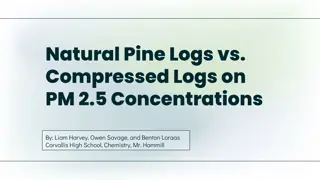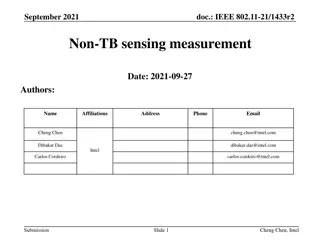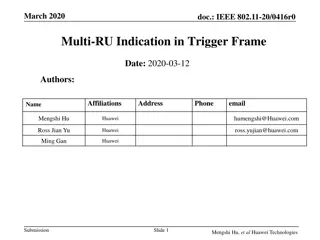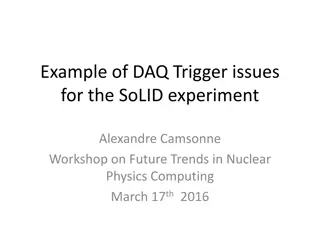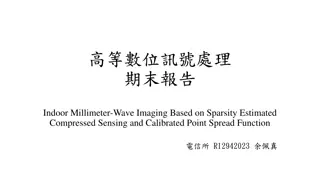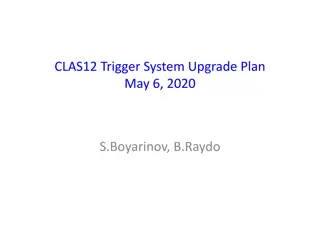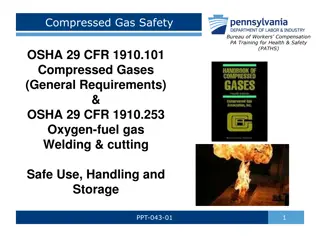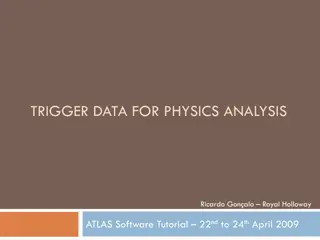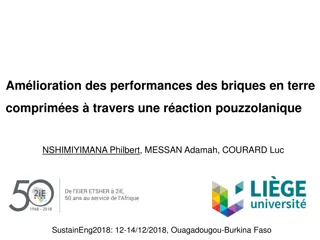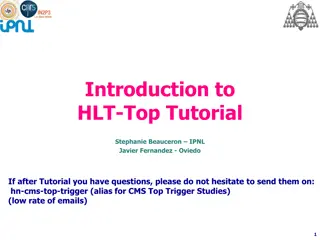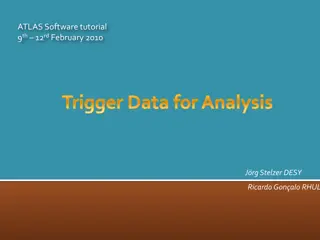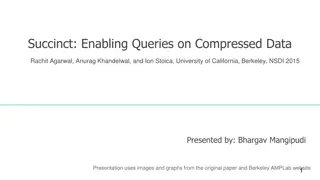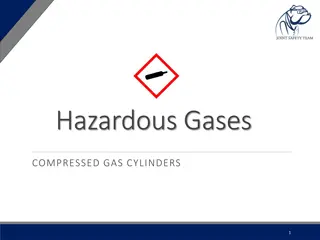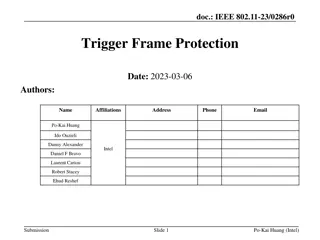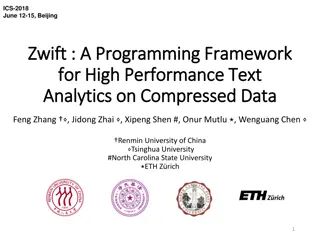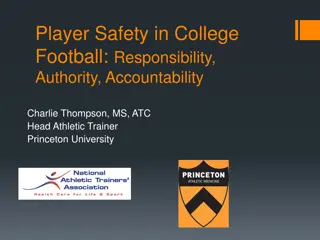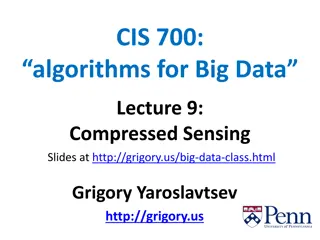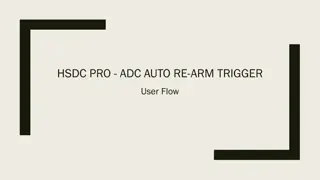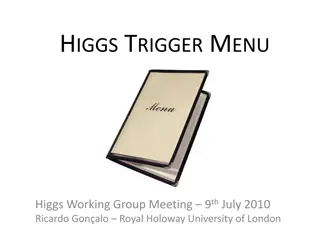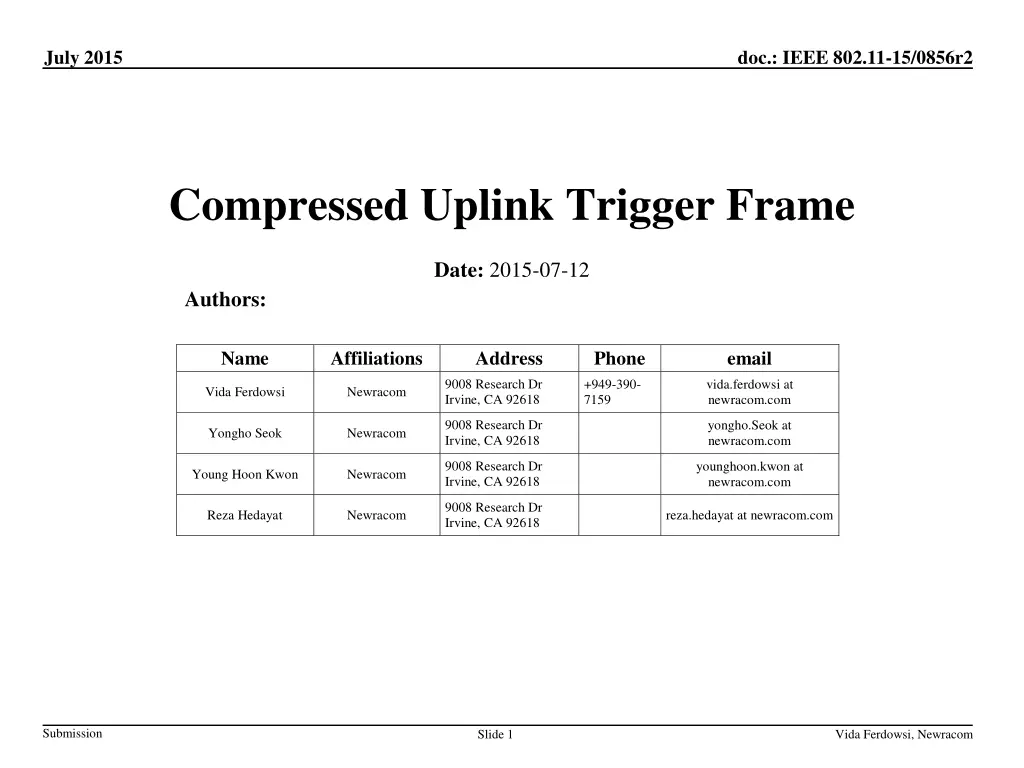
IEEE 802.11-15/0856r2 Uplink Trigger Frame Options
Explore the options for uplink trigger frames in IEEE 802.11-15/0856r2, including the multiplexing of DL acknowledgments, transmission scheduling, overhead considerations, and synchronization issues. Options range from single transmission opportunities to multiple TR transmissions during UP link TXOP, each with its pros and cons for aperiodic and periodic traffic scenarios.
Download Presentation

Please find below an Image/Link to download the presentation.
The content on the website is provided AS IS for your information and personal use only. It may not be sold, licensed, or shared on other websites without obtaining consent from the author. If you encounter any issues during the download, it is possible that the publisher has removed the file from their server.
You are allowed to download the files provided on this website for personal or commercial use, subject to the condition that they are used lawfully. All files are the property of their respective owners.
The content on the website is provided AS IS for your information and personal use only. It may not be sold, licensed, or shared on other websites without obtaining consent from the author.
E N D
Presentation Transcript
July 2015 doc.: IEEE 802.11-15/0856r2 Compressed Uplink Trigger Frame Date: 2015-07-12 Authors: Name Affiliations Address Phone email 9008 Research Dr Irvine, CA 92618 +949-390- 7159 vida.ferdowsi at newracom.com Vida Ferdowsi Newracom 9008 Research Dr Irvine, CA 92618 yongho.Seok at newracom.com Yongho Seok Newracom 9008 Research Dr Irvine, CA 92618 younghoon.kwon at newracom.com Young Hoon Kwon Newracom 9008 Research Dr Irvine, CA 92618 Reza Hedayat Newracom reza.hedayat at newracom.com Submission Slide 1 Vida Ferdowsi, Newracom
July 2015 doc.: IEEE 802.11-15/0856r2 Abstract An UL MU transmission has been defined as a sequence of UL-TR frame, UL MU PPDU and ACK An UL MU PPDU (MU-MIMO or OFDMA) is sent as an immediate response (IFS TBD) to a Trigger frame (format TBD) sent by the AP. [1] The amendment shall define a mechanism for multiplexing DL acknowledgments sent in response to UL MU transmissions. [1] UL MU transmission extension in one TXOP Submission Slide 2 Vida Ferdowsi, Newracom
July 2015 doc.: IEEE 802.11-15/0856r2 Option 1: A TR schedules all uplink transmissions TXOP ACK/ BA ACK/ BA ULTR AP Padding Padding STA 1 STA 4 Padding Padding STA 2 STA 5 Padding Padding STA 6 STA 3 time Cons: Pros: Synchronization problem Padding overhead for aperiodic traffic (since AP should know about STAs queue status) Nodes can go to the sleep mode Less TR overhead Useful for periodic traffic Submission Slide 3 Vida Ferdowsi, Newracom
July 2015 doc.: IEEE 802.11-15/0856r2 Option 2: More than one TR can be transmitted during UP link TXOP (1/2) TXOP ACK /BA ACK /BA ULTR ULTR A P Padding Padding STA 4 STA 1 Padding Padding STA 2 STA 5 Padding Padding STA 6 STA 3 time Cons: Pros: Nodes cannot go to the sleep mode TR over head can be high Padding overhead for aperiodic traffic, since AP doesn't know the buffer status of STA No synchronization problem Submission Slide 4 Vida Ferdowsi, Newracom
July 2015 doc.: IEEE 802.11-15/0856r2 Option 2: More than one TR can be transmitted during UP link TXOP (2/2) Padding overhead for aperiodic traffics can be solved with polling and with multiple transmission per group of users TXOP Polling Polling ACK /BA ACK /BA ACK /BA ACK /BA ULTR ULTR ULTR ULTR AP STA 1 STA 4 STA 1 STA 2 STA 3 STA 4 STA 2 STA 3 STA 5 STA 5 STA 6 STA 6 tim e Pros: Cons: Scheduling is simpler for aperiodic traffics Synchronization is simpler TR Overhead is high Submission Slide 5 Vida Ferdowsi, Newracom
July 2015 doc.: IEEE 802.11-15/0856r2 A simple comparison Case 2: Case 1: TXOP TXOP ULTR ULTR ULTR BA BA BA AP A P STA 1 STA 1 STA 1 STA 2 STA 2 STA 2 STA 3 STA 3 STA 3 time time Assumptions Length of padding and UL data are the same for all STAs (for simplicity) n: number of STAs per group m: number of transmissions per group ???????: Length of the fixed part of TR ?????????: Length of UP transmission info per STA ??????: Length of Uplink frames ?????????: Length of Padding ????????????????1= ???????+? ?????????+ ??????+ ????????? ????????????????2 = m ???????+m ? ?????????+ ?????? Therefor e if ????????????????2 > ????????????????1 ? ???????+ ? ? ????????? > ????????? If the length of ????????? is large, the overhead of polling strategy will be high. Submission Slide 6 Vida Ferdowsi, Newracom
July 2015 doc.: IEEE 802.11-15/0856r2 Solution: Avoiding retransmitting TRelements Compressed Trigger Frame ACK /BA ACK/ BA ACK /BA ACK/ BA UL TR UL TR UL TR AP STA1 STA 4 STA 1 STA 4 STA 5 STA 2 STA5 STA2 STA 6 STA 3 STA3 STA6 tim e STAs can use information from previous TR to transmit its uplink frames. Submission Slide 7 Vida Ferdowsi, Newracom
July 2015 doc.: IEEE 802.11-15/0856r2 Compressed Trigger Frame (option 1) Same resource allocation is repeated for the same group of STAs. If More elements field has NOT been set, it means the trigger frame dose NOT contain resource allocation elements. STA shall save the information of TRs per TXOP. If the identifier of compressed TR is same as the identifier of the saved TR, then STA shall use the saved information for uplink transmission. Submission Slide 8 Vida Ferdowsi, Newracom
July 2015 doc.: IEEE 802.11-15/0856r2 Compressed Trigger Frame (Option 2) A subset of assigned group transmits with the same uplink transmission information but on different sub-channels. AP by setting previous assignment filed in BA per STA notifies that STA shall use the previous uplink transmission settings after receiving a compressed TR. AP may assign new sub-channel range in BA. STA shall use the saved information for transmitting an uplink frames, if the the identifier of the compressed TR is same as identifier of the regular TR. Submission Slide 9 Vida Ferdowsi, Newracom
July 2015 doc.: IEEE 802.11-15/0856r2 Straw Poll Do you agree to add the following sentence SFD: Per-user information in the Trigger Frame may be omitted for scheduled STA(s). Submission Slide 10 Vida Ferdowsi, Newracom
July 2015 doc.: IEEE 802.11-15/0856r2 Reference [1] IEEE 802.11-15/0132r5 Specification Framework for TGax Submission Slide 11 Vida Ferdowsi, Newracom

